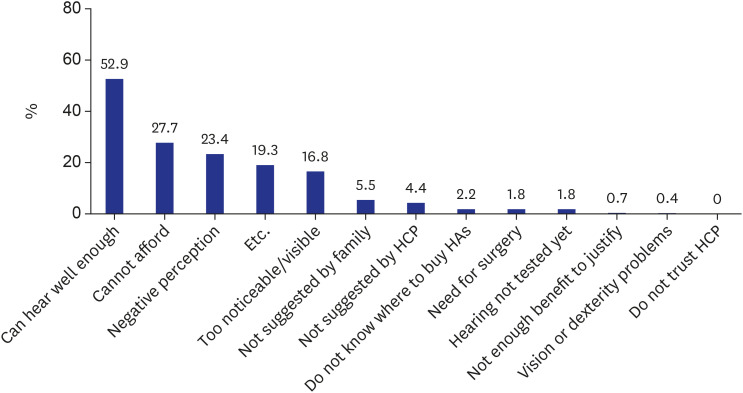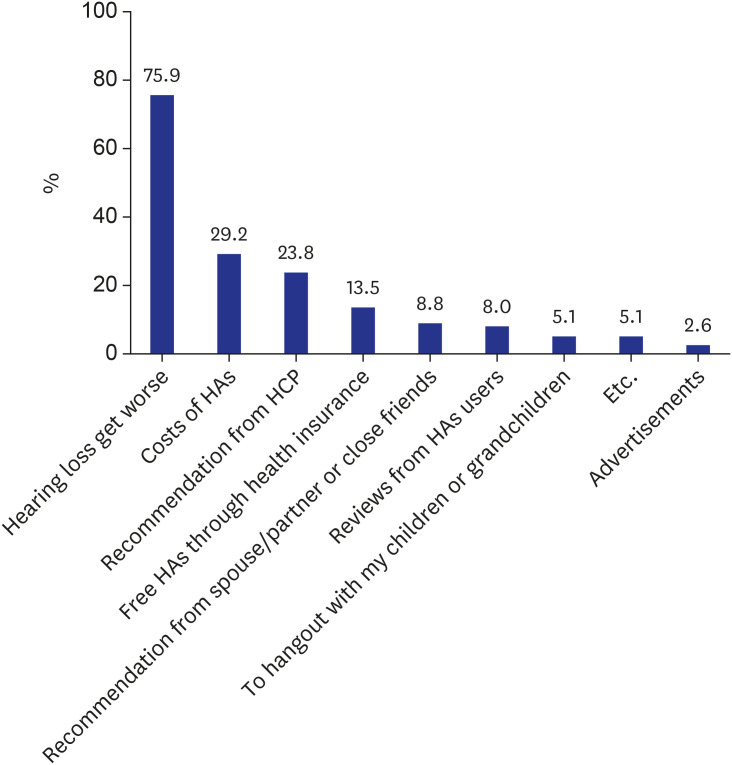J Korean Med Sci.
2022 Jan;37(2):e11. 10.3346/jkms.2022.37.e11.
Factors Influencing Hearing Aid Adoption in Patients With Hearing Loss in Korea
- Affiliations
-
- 1Hearing Research Laboratory, Samsung Medical Center, Seoul, Korea
- 2Department of Otorhinolaryngology-Head and Neck Surgery, Samsung Medical Center, Sungkyunkwan University School of Medicine, Seoul, Korea
- 3Demant Korea Co., Ltd., Seoul, Korea
- 4Medical Research Institute, Sungkyunkwan University School of Medicine, Suwon, Korea
- 5Center for Clinical Epidemiology, Samsung Medical Center, Seoul, Korea
- KMID: 2524282
- DOI: http://doi.org/10.3346/jkms.2022.37.e11
Abstract
- Background
The purpose of this study was two-fold: 1) to identify differences in the characteristics of adopters and non-adopters of hearing aids (HAs); and 2) to investigate factors influencing the purchase of HA.
Methods
This study was conducted among 1,464 subjects (818 male and 646 female) with hearing loss. A national face-to-face survey was performed from August 2019 to October 2020 by otologists or HA experts. The questionnaire consisted of three domains: demographic, audiological, and HA-related domains. Multivariate logistic regression analysis was performed after adjusting for degree of hearing loss.
Results
The mean age of the participants was 70.4 ± 12.2 years. Of the 1,464 respondents, 1,190 (81.3%) had already purchased HA. We identified educational level, household income, hearing loss period, place of HA purchase, and government HA assistance program status as factors influencing HA adoption. Among these factors, third party reimbursement was the most important factor affecting HA purchase intent. The main reasons for not adopting HA were feeling that their hearing was adequate, inability to afford HA, and perceptions that HA are uncomfortable.
Conclusion
Various factors are involved in the purchase of HA, but disabled registration status and third party reimbursement were identified as the most critical factors. In the future, the government should take a more active role in increasing the distribution of HA to patients with hearing loss.
Figure
Reference
-
1. World Health Organization. Deafness and hearing loss. Updated 2021. Accessed April 16, 2021. https://www.who.int/news-room/fact-sheets/detail/deafness-and-hearing-loss .2. Hyun KR, Kang S, Lee S. Population aging and healthcare expenditure in Korea. Health Econ. 2016; 25(10):1239–1251. PMID: 26085120.
Article3. United Nations. World population prospects 2019. Updated 2019. Accessed April 3, 2021. https://population.un.org/wpp/Download/Standard/Population/ .4. Loughrey DG, Kelly ME, Kelley GA, Brennan S, Lawlor BA. Association of age-related hearing loss with cognitive function, cognitive impairment, and dementia: a systematic review and meta-analysis. JAMA Otolaryngol Head Neck Surg. 2018; 144(2):115–126. PMID: 29222544.5. Song JJ, Ku EJ, Kim S, Kim E, Choi YS, Jung HJ. Increased risk of psychopathological abnormalities in subjects with unilateral hearing loss: a cross-sectional study. Clin Exp Otorhinolaryngol. 2021; 14(1):82–87. PMID: 32734740.
Article6. Moon IJ, Baek SY, Cho YS. Hearing aid use and associated factors in South Korea. Medicine (Baltimore). 2015; 94(42):e1580. PMID: 26496259.
Article7. National Evidence-based Healthcare Collaborating Agency (KR). Analysis of hearing aid benefit and barriers in hearing aid acquisition in Korea (NECA 2010-008). Updated 2021. Accessed April 16, 2021. https://policy.nl.go.kr/search/searchDetail.do?rec_key=SH2_PLC20170213095 .8. Powers TA, Rogin CM. MarkeTrak 10: Hearing aids in an era of disruption and DTC/OTC devices. Hear Rev. 2019; 26(8):12–20.9. Hougaard S. EuroTrak. Updated 2011. Accessed April 16, 2021. https://www.hearingreview.com/hearing-products/amplification/assistive-devices/eurotrak .10. Jorgensen L, Novak M. Factors influencing hearing aid adoption. Semin Hear. 2020; 41(1):6–20. PMID: 32047345.
Article11. Kochkin S. MarkeTrak VII: Obstacles to adult non-user adoption of hearing aids. Hear J. 2007; 60(4):24–51.12. Kochkin S. MarkeTrak VIII: Consumer satisfaction with hearing aids is slowly increasing. Hear J. 2010; 63(1):19–20.
Article13. Simpson AN, Matthews LJ, Cassarly C, Dubno JR. Time from hearing aid candidacy to hearing aid adoption: a longitudinal cohort study. Ear Hear. 2019; 40(3):468–476. PMID: 30085938.
Article14. Ogawa T, Uchida Y, Nishita Y, Tange C, Sugiura S, Ueda H, et al. Hearing-impaired elderly people have smaller social networks: a population-based aging study. Arch Gerontol Geriatr. 2019; 83:75–80. PMID: 30965190.
Article15. Choi JE, Moon IJ, Baek SY, Kim SW, Cho YS. Discrepancies between self-reported hearing difficulty and hearing loss diagnosed by audiometry: prevalence and associated factors in a national survey. BMJ Open. 2019; 9(4):e022440.
Article16. Kim GY, Kim JS, Jo M, Seol HY, Cho YS, Moon IJ. Feasibility of personal sound amplification products in patients with moderate hearing loss: a pilot study. Clin Exp Otorhinolaryngol. Forthcoming. 2021; DOI: 10.21053/ceo.2020.02313.
Article




